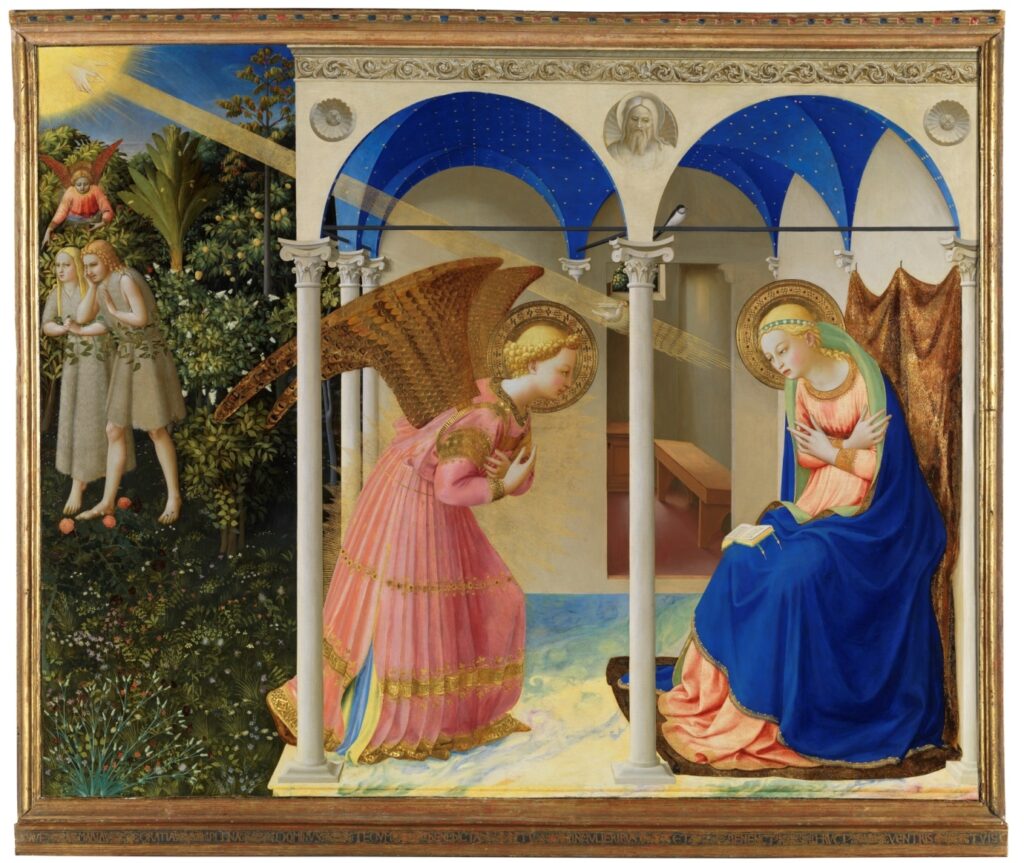
By the Revd Canon Ian Mortar
Today, 25 March is the Feast of the Annunciation, the day when we celebrate the visit the Angel Gabriel made to the Blessed Virgin Mary to announce that she had been chosen by God to be the bearer of his Son, the long expected Messiah. The details of this angelic visitation are recorded for us in St Luke’s Gospel Chapter 1 verses 26 – 38. Last year I shared with you one of my favourite paintings of the Annunciation by the African-American Artist Henry Ossawa Tanner. This year I reflect upon perhaps the most well-known Annunciation paintings from Italian Renaissance by Fra Angelico. This painting is in the Prado Museum in Madrid.
Originally painted in about 1435 for a side altar in the Convent of San Domenico, Fiesole, where Fra Angelico was a friar. The painting remained in the Convent’s Church in the delightful small town of Fiesole above the city of Florence until 1611 when it was sold to the King of Spain and taken to Madrid, where it became part of the royal collections of the Spanish monarchy before moving eventually to the Prado.
The scene is very much like the fresco by the same artist in the Convent of San Marco in Florence where there is perhaps the largest collection of Fra Angelico paintings. But in the Prado version, the picture is divided into three parts; the garden, the Angel’s arch and the Virgin’s arch. On the left of the scene we see Adam and Eve being expelled from Garden of Eden passing through the flowering garden which represents the virginity of Mary. There are also a multitude of plants and seedlings and because of the accuracy of the botanical painting we can interpret their symbolism. We recognise the palm, representing the future martyrdom of Christ, and the red roses referring the blood of the Passion. The presence of Adam and Eve reminds us of the fall of humanity as symbolised in the opening Chapters of Genesis which is restored through the deliverance of Jesus Christ made possible by the acceptance of Mary at the Annunciation, the second Eve.
Also from the high-left hand side we see the ray of divine light with the hand of God the Father that illuminates the scene and through which the dove of Holy Spirit, comes with ‘the power from on high’ upon the Virgin Mary as she become the Theotokos, the Bearer of God. Mary who bends her head with arms crossed accepts this honour and duty submissively. She’s sitting on a seat covered with the ‘cloth of honour’ that hangs on the wall behind her, and she has on her knees an open book, perhaps of the Holy Scriptures whose purposes she is fulling in being the person who enables Messiah to enter the world.
The Angel has a similar pose of arms crossed as the servant messenger of God but also perhaps honouring the Mother of God who had accepted the saving purposes of God. The whole scene is set within a renaissance portico with the light arches decorated with the blue celestial canopy reminiscent of so many churches of the time. The overall effect of this divine intervention in the life of humanity is a precious description of peace and salvation the ‘beginning of our rescue’.
I was asked last weekend by a member of the congregation ‘Why Pink for Mothering Sunday?’ Well, actually the vestments are technically the colour ‘rose’ but you can be forgiven for not noticing the difference. So what’s this all about? This coming Sunday, Lent 4 is about half way through Lent, well to be precise the halfway point is actually the Thursday before, but since Christians usually gather on Sundays the halfway point is marked on that day instead. Lent is long and penitential. Since this Sunday is about halfway, the Church tries to give people encouragement to make the rest of the journey through Lent. The use of the rose colour, rather than the normal Lenten Array or Purple is brighter and brings a day of lightness during the forty days of Lent.
Before the popularity of ‘Mother’s Day’ this Sunday was often called ‘Laetare Sunday’ and ‘laetare’ means “rejoice,” It is the first word in the Latin version of the introit, a short piece of Scripture or Psalm that is sometimes sung or read at the beginning of the Eucharist. On Lent 4 the introit begins, ‘Laetare Jerusalem: et conventum facite omnes qui diligitis eam.’ which is translated, “Rejoice, O Jerusalem: and come together all you that love her.’ This is a verse from the Prophecy of Isaiah 66.10.
But typical of the Church this Sunday also has other names and these include: Refreshment Sunday, Rose Sunday, Mid-Lent Sunday, and Mothering Sunday. Refreshment Sunday, as it was a day when the austerity of the Lenten fast was relaxed and ‘more normal fare’ was eaten. This included in our country the eating of Simnel Cake, the rich fruit cake not only topped with marzipan but also in a layer baked within the centre of the cake.
Perhaps the most popular and well know is Mothering Sunday, because there used to be a tradition that Christians would either visit or give an offering to their mother church, or cathedral church, on this Sunday.
And so we come to ‘Why Pink’? Or perhaps as our Company of Tapiser’s at the Cathedral would correct me, rose! In ancient times the Roman Church called this Rose Sunday from a tradition when the Pope wore rose coloured vestments on this day and this might be because there was a medieval custom that on this Sunday the Pope would bless an assortment of roses made of gold, which he would then send as to Catholic rulers as gifts.
Have a happy and holy Laetare Sunday!